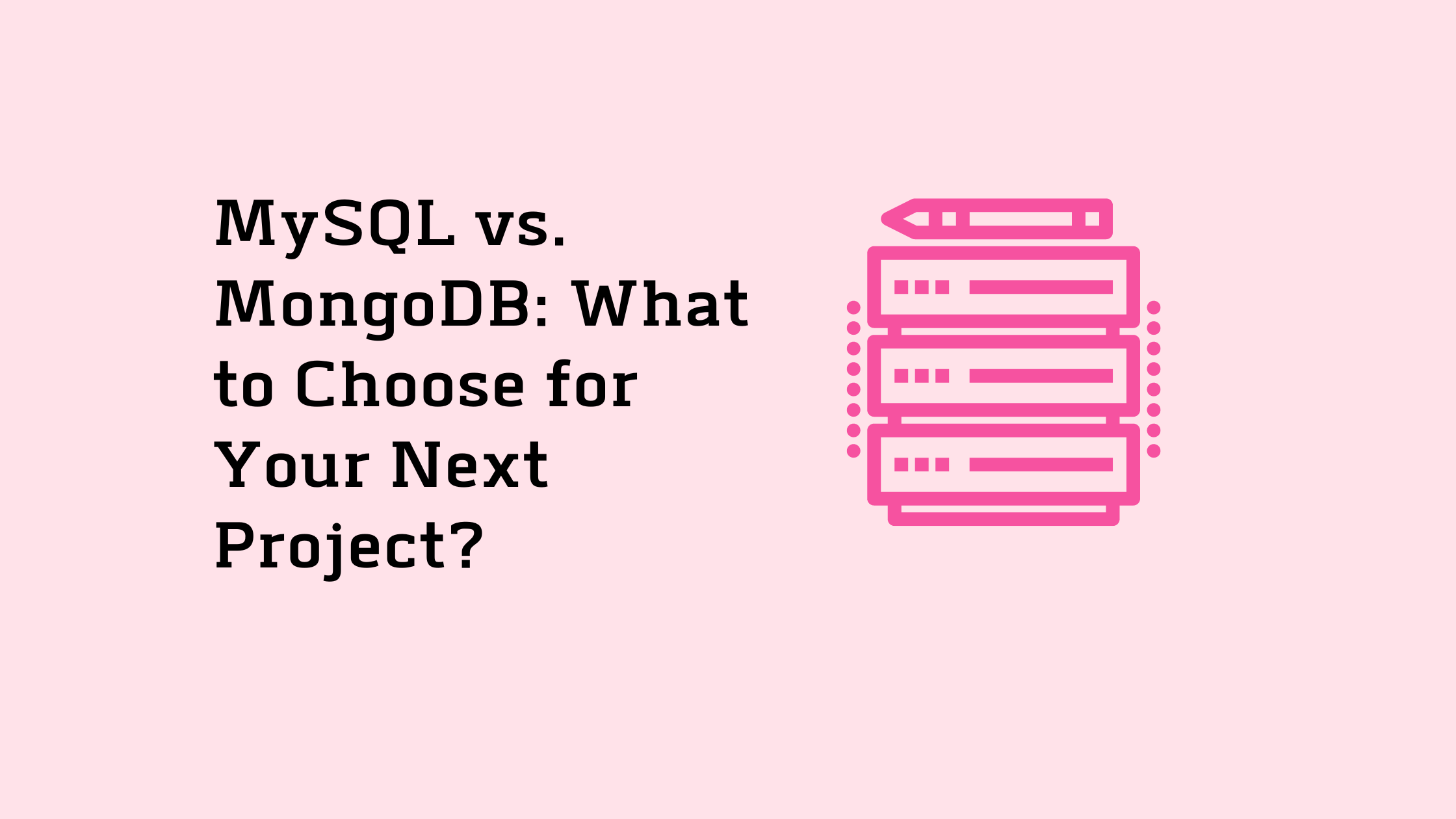Recent trends in database adoption and popularity have been interesting. The ranking of DB Engines shows that open-source solutions are rapidly gaining traction while commercial software is losing its appeal. This trend is evident in the MongoDB vs. MySQL contest. Consider comparing MySQL vs. MongoDB.
A switch from relational databases toward non-relational databases is another trend that could be more obvious but still exists. Analyzing the most common tools, MongoDB and MySQL, for relational solutions is often the first step in choosing a database.
MySQL: A quick description

Youtube, Amazon, Adobe, and LinkedIn to store their website data. MySQL powers approximately 9 out of 10 websites on the Internet.
Always regard the importance of RDBMS Databases, ACID Databases, Form of Tables, Table Sachems, Storage Format, Storage Systems, and Difference between Count.
MySQL and MongoDB are used in Atomic Operations.
Also, MongoDB is important to the 13ms Mongo for Load Increase and Automatic Load Balancing, plus Cloud-Based Services in Vertical Scaling.
MySQL’s rich, tested, and proven ecosystem is one of the main benefits. Many educational resources, proven tech stacks, guides, and other support exist. It’s an SQL-based relational SQL database that developers can integrate with other SQL solutions like PostgreSQL or even migrate the entire project. In software development for enterprise businesses, there is a chance of missed deadlines, budget overruns, and even surprises.
MySQL is well-known for supporting complex queries, logical operations, and transactions. MySQL is also known for being one of the most secure databases available. There will be a manifold rise in the Total number of web developers in addition to digital interface designer jobs using the technologies mentioned above in the United States during 2020 and 2030
MongoDB: A quick description

MongoDB, a non-relational database, doesn’t use SQL tables or tables the same way relational databases do. MongoDB instead creates documents that contain related information and uses a custom language – Mongo Query Language – for communication.
Each document can have its structure and be able to govern different types of data. Developers don’t need to connect tables or add columns, which leads to faster development. Because there is no need to learn SQL, the learning curve is lower.
MongoDB’s flexible data model is the main benefit. There is no need to use a single schema throughout the development process. Each document has its structure. It is much easier to scale, edit the database structure, or add new records.
What is the main difference between MongoDB and MySQL?
MySQL and MongoDB clearly show differences in development methods between SQL and NoSQL databases. Both databases have advantages and disadvantages and can be used differently. Consider the best use of MongoDB and My SQL in Digital Agencies, App Development, Apps Development, App Development Services, Mobile Apps Development, Phase Of Development, and Software Development Processes.
What is the main difference between MongoDB and MySQL?
MySQL is a relational database.
All data is stored in tables.
Developers can see connections and sort duplicate, damaged, or irrelevant information. One table can be easily modified, so it is unnecessary to alter a large document.
Tables offer a higher level of organization but require more preparation. Tables can’t represent all data properly, especially large text files such as honest answers in user registration.
A portfolio of satisfied customers is a positive signal for the next stage.
MySQL development characteristics:
A team plan and a relational structure are important, requiring lots of organization.
Different applications can easily access data.
MySQL can handle long-term projects easily – many sites built with MySQL work for at least 10-15 years.
Stability for the long-term: All data has been sorted, so there are no duplicates or unrelated entries.
MongoDB doesn’t require developers to organize data before it can be entered into a database. Because there is room for continuous change, the database makes it easy to build software quickly. Developers don’t need to be restricted by schemas or relationships between tables. MongoDB can build databases for one application. It will provide high scalability as well as fast performance.
MongoDB does not provide any algorithms to control the interactions between databases. MongoDB is the best choice for short-lived, simple applications where data organization is not a priority.
MongoDB development characteristics:
Using documents instead of tables eliminates the need for data sorting and predefines the database schema.
● Rapider development
● You can easily scale: You can modify anything at any time.
● JSON documents do not require extra organization.
Language
MySQL is an SQL database that uses Structured Query Language (SQL) to organize and describe data. MongoDB, a non-SQL SQL database, uses a mixture of general-purpose programming languages. It was written in JS and Go, C++, and Python.
Before uploading data to SQL, developers must define the schema for the database. The information must be organized to make it easy to create tables. It’s an excellent representation method for numeric data. It is, however, difficult to convert non-standard content into a classic relational model.
MySQL vs. MongoDB scalability
SQL databases allow vertical scaling: Developers can increase the server load to perform operations. Scalability requires increasing the CPU, SSD, RAM, and RAM on the server.
Nosql databases permit you to add more servers than one. This approach is much more efficient. No matter how powerful, one server cannot perform as well as multiple servers.
MySQL sharding
Developers prefer to split a single server into multiple partitions to accommodate large databases and many transactions. Each partition can be installed on its server, allowing MySQL to use horizontal and vertical scaling.
Teams use frameworks to perform MySQL sharding. Google uses Vitesse for Youtube Sharding – it is open-source software. Twitter and Facebook use custom sharding to meet the requirements of their vast MySQL databases. They can accomplish much more through the capabilities of AI (Artificial intelligence to transform business)
MongoDB horizontal scaling and sharding
MongoDB makes it possible to do sharding without the need for additional frameworks. Developers can create replica sets in the application and store different documents across different servers.
MongoDB replication is stronger than MySQL. Data replication does not require any migration to the framework. It is intuitive and quick.
Administration
Teams will be responsible for administering and maintaining a database throughout the application’s lifetime. It is responsible for backup creation, updating, and handling workloads.
MySQL MongoDB administration
Although MySQL has many options for replicating a database, each is slightly different. MySQL offers a variety of methods for managing databases. Let’s look at some of the more common approaches.
MySQL’s advantages and disadvantages
Let’s now look at using checklists for MySQL vs. MongoDB benefits and disadvantages.
Rapid performance: As the project grows, it becomes difficult to handle large documents. MySQL is the best-performing option for language platforms.
High stability: A predefined schema gives developers a stable structure that allows them to systemize their data, control its compatibility and detect duplication. Databases are more reliable and predictable.
Security: SQL follows ACID principles, so transactions are carefully approved, monitored, and isolated. MySQL offers many additional settings that allow for isolation and access management.
Developers are at the organization’s top; they can see the relationships between data and quickly spot errors. Consider the following options App Development Services, Mobile Apps Development, Phase of Development, etc.
Predefined schemas can be reused on multiple projects. This aspect reduces the need for additional preparation. A more proficient team in SQL development will be able to develop the optimal schema faster. Consider comparing MySQL vs. MongoDB.
Developers can save MySQL procedures as portable procedures.
They will work on multiple OSs and applications.
One operation can be written and distributed to various applications.
Advantages
Difficulty in database organization: A schema cannot be modified during development. This aspect will involve transferring data back and forth and updating all relations.
Editing tables can be time-consuming. Developers need to ensure that data adheres to multiple database standards. Incorrect relation setup or typos can impact the performance of the whole table.
Data organization is mandatory: Developers can only add information to a table by structuring it in a column-row format.
Poor data accommodation: All data must fit in a table. It is fine for some information, such as emails or numbers. Large entries (texts and honest answers) may need help to fit or be difficult for others to connect.
Consider comparing MySQL vs. MongoDB.
MongoDB’s advantages and disadvantages
NoSQL MongoDB’s approach is often different from what MySQL offers. Their benefits and drawbacks are often inverted. MongoDB did not inherit some of the positive SQL traits, but it was able to address several critical issues. It can create highly performant desktop and mobile applications with HTML, CSS, and JavaScript.
It supports native code rendering that NodeJS supports.
Advantages
Flexibility: A JSON document can be edited anytime and does not affect other files. JSON documents can be edited independently of SQL. SQL changes can have a significant impact on the whole structure.
Support for unstructured data: Developers don’t have to insert information into columns and rows. Sub-documents and arrays are easier and more flexible.
High readability: MongoDB does not require developers to access other tables to gather related information. All data can be accessed in one document.
Developers don’t have to plan or predefined schemas.
Advantages
MongoDB documents at a lower level: MongoDB documents can become messy over time if developers aren’t prioritizing the organization.
Duplication: MongoDB doesn’t detect recurrence automatically. Developers can, however, use additional tools to see repeated content in documents.
High CPU usage: MongoDB offers faster performance but at the cost of the CPU. We’ve seen the graph.
Databases are larger: The database will likely grow 2-3 times faster if developers don’t sort documents than the respective MySQL data layer.
MySQL Use Cases
MySQL is the best choice for large platforms that value security and stability. MySQL is a great choice for businesses that value stability, reliability, reputation, and long-term reliability over MongoDB’s simplicity. Here are some reasons to use MySQL. Hybrid apps built on these platforms can be used with many apps; they can provide an experience native to the app in terms of UI/UX and push notifications.
Which is better to use MongoDB or MySQL
Applications for eCommerce
E-commerce platforms handle much numerical data that is easy to decode into SQL structures. E-commerce platforms can run without the downtime and manage large workloads with high stability and security.
MySQL stores product catalogs, purchase histories, and transaction data prices. Developers may also integrate non-relational databases like MongoDB to provide analytics and synchronized information. Every web development project is distinct, and when you need to know the size of your project and objectives, it’s difficult to provide a proper guideline on which web developers will fit your needs the most.
LAMP Open-source stack
MySQL is used in the popular open-source tech stack, which consists of Linux and Apache. LAMP offers many advantages, including a free, well-developed, and rich ecosystem. LAMP is an excellent choice for web development and multi-page applications.
Websites of the government
MySQL is the database that powers NASA, US Navy, and the United Nations web platforms. It is also used for classified scientific research, such as MySQL storing CERN data. MySQL is a trusted choice for sensitive data storage due to its ACID compliance and wide range of security customizations.
Governmental organizations need to prioritize speed and scalability. They instead focus on safety and long-term sustainability. Consider comparing MySQL vs. MongoDB.
MongoDB use cases
Companies use MongoDB
MongoDB is the best choice for platforms that deal with non-numeric information. The non-relational database can often handle large amounts of text, images, and real-time analytics. MongoDB is our preferred choice for data-driven content projects.
Asset management and item catalogs
Developers can break product data into multiple tables using the JSON document structure. It is easy to store all the product data along with metadata. Teams can create different categories. Developers can add documents to support new types and analytics as the platform grows. There’s no need for the whole database to be affected. There are three kinds of developers on the web. Backend, front-end, and full-stack designers.
Analytics in real-time
A database must be flexible enough to allow data collection per minute or second. With custom tools, the pre-designed schemas of SQL databases can handle large volumes of continuously changing data. On the other hand, MongoDB can deal with large volumes of constantly changing data thanks to its flexible structure and ability to handle unstructured and GPS data. Consider comparing MySQL vs. MongoDB.
Content Management
Many companies have switched to MongoDB CMS because it is more flexible and scalable than MySQL. Forbes is one of these companies. SQL solutions like MySQL limit teams to schemas that need to be more adaptable to user needs, can hold multiple assets together, and don’t allow for rapid growth. It takes time to create new relationships between databases in SQL tools. These connections may only sometimes be accurate.MySQL is one of the most extensively employed databases. It has been at the top of the database rankings for many years. Facebook, Uber, and Paypal use MySQL,
Which is better to use MongoDB or MySQL?
MongoDB is not a MySQL substitute for the moment.
MySQL is a better choice than NoSQL solutions for many use cases. SQL is still the standard for data storage, processing, and management.
NoSQL databases are faster and more efficient than traditional ones but need more organization and stability. Both tools can be used together, solving different technical problems and catering to their respective uses in the following:
1. Open-Source
2. Non-Relational Data…
3. Structured SQL Database
4. Database Implementation
5. Database Support Caching
6. Database Systems
Consider the Increase In RDBMS Database and Manpower For Database Management as well as Non-Relational Database plus Database In Nature and Detailed Database Model.
Remember the use of Distributed databases, Query Access, Simple Queries, Limited Join Queries, Query Performance, and Standard Query Language. Always improve Application Performance and Disruption plus Fixed Data and Processing Data Costs. Consider Simpler Data Models and MongoDB Compass in a Transaction Model for Business With Ease with Full-Text Search, Term Search, plus Boolean Search.
Conclusions
MySQL is a proven system with us to be a rich ecosystem of features that adheres to high-security standards. However, increased reliability comes at the cost of lengthy preparations and upfront decisions. MongoDB is simpler than Squash Apps to develop and scale, and its JSON structure makes it more flexible than the comparative table. It needs to be more secure and well-organized, making it less suitable for confidential information storage. Consider comparing MySQL vs. MongoDB.

Dr.Supreena has published two international books in finance with the able guidance of her guide and department at Ethiraj College of Women, University of Madras during her PhD in Economics and Finance. She is the Recipient of Dr Vedagiri Shanmugasundaram (An Oxford Scholar) Award for Outstanding and Successful PhD Candidate from Ethiraj College for Women concerning research record and academic distinction. She is experienced in the domain of finance, digital marketing and information technology writing on Artificial Intelligence, IoT, PaaS and SaaS cloud computing etc. She is NIIT qualified in Advanced Network Computing, Google Certified in digital marketing. Her hobbies to maintain balance and reduce stress are gardening and cooking.


